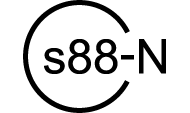S88 and s88-N cabling

The S88-bus is probably the most widespread standard for connecting feedback decoders to a digital system. Most central units have a connector for S88. Even if your central unit is not compatible with S88, you can choose from several solutions to connect S88 decoders to your system. For example: the HSI-88 from Littfinski.
The S88-bus is not very intelligent. Technically speaking it is not even a data bus, but one big shift register. The feedback decoder translates its contacts into bits and bytes. When the status of the contacts is read, all the bits are pushed one by one to the central unit. There is no error correction or any other technique to suppress errors.
To cut a long story short, S88 is cheap solution for feedback decoders, but other electrical signals might induce errors on the bus. A lot of discussion has been going on about what is exactly causing the problems some people are having. A big step forward is replacing the standard (expensive) S88 cables by cheap UTP network cables. The desire to use these cables was one the main reasons for me to start developing my own feedback decoders years ago.

A new standard: s88-N
More people had noticed the advantages of using network cables. A group of hobbyists and manufacturers finally agreed on a standard pin layout for RJ-45 connectors and network cables. This wiring standard is called s88-N (sometimes written as S88N). S88-N compatible decoders and equipment can be identified by the s88-N logo. You can learn more about s88-N on the website of Wolfgang Kufer about OpenDCC. Or take a look at s88-N.eu.
The BMD16N-SD is fully compatible with s88-N and - like its predecessors - it features 16 independent contacts with integrated current detection. I have also designed a normal, improved, feedback decoder for s88-N: the BMD16N.

The advantages of network cables are no ghost story. The cables provide better protection from electrical influences and that really makes a difference. While building De Lage Zij I ran into strange problems with feedback decoders. After replacing the old decoders by BMD16N-SDs with network cables all problems suddenly vanished.
The plugs on the network cables are also a lot better than the silly strip connectors of a standard S88 cable. They snap into the connectors on the board and it is impossible to connect them the wrong way. Network cables can be bought virtually anywhere at low prices. They are available in any length you might desire. If that is not enough, you can always create your own with a crimper. There are numerous websites out there that will tell you how to do it.

You do not want to discard your old decoder when you switch to S88-N. And you do not have to. I have made a small circuit board for a s88-N adapter. The board splits into two halves. One will translate S88 to s88-N, the other s88-N to S88. You plug both halves of the adapter into an old S88 decoder with the white arrows pointing in the direction of the central unit. The decoder can now be connected as if it were a s88-N decoder.
Please note: connect all adapters and decoders with all white arrows pointing in the direction of the central unit!
The adapter can also be used to create to turn the S88 connection on the central unit into a s88-N one. Just plug the adapter into the back of the central unit and you you can directly connect s88-N network cables to it. This will help you to create a feedback system that is as error free as possible. The RJ-45 connector for the adapter can be ordered from Conrad as part number 716148, the strip connector as 741120.

Especially for connecting s88-N decoders under layout segments, I created a small board with to s88-N coupler connectors. You can use the board side by side with the Universal Module Connector under your segments. If you cut the board in half, you get two separate couplers for s88-N.
| s88-N wiring standard | |||
| RJ45 pen | Colour in UTP cable | s88-N, BMD16N, BMD16N-SD | |
| 1 | Orange-white | +5V/+12V | |
| 2 | Orange | Data | |
| 3 | Green-white | GND | |
| 4 | Blue | Clock | |
| 5 | Blue-white | GND | |
| 6 | Green | Load | |
| 7 | Brown-white | Reset | |
| 8 | Brown | Railsignaal | |
Boards are available from the shop.
2008
